COLUMBUS, Ohio -- Until Mike Matheson's injury in late February, the Penguins remarkably went over three months without any of their top six defensemen getting injured to the point that it would keep them out of the lineup.
When Matheson hit the shelf, Mark Friedman was the first blue liner presented with an opportunity to fill the vacancy.
Friedman played so well that he earned himself a spot in the lineup even upon Matheson's return, supplanting Marcus Pettersson who has been healthy-scratched in consecutive games.
While I'd argue Pettersson's performance this season doesn't warrant being healthy-scratched, it's encouraging, and quite frankly refreshing that Mike Sullivan is getting creative and testing out new combinations on the backend.
The Penguins already know what they have in partnerships between Brian Dumoulin and Kris Letang, as well as Pettersson and John Marino. As a virtual lock to make the postseason, there's no harm in doing some experimenting down the stretch.
There's also the possibility that Pettersson ends up in some sort of trade package that helps the Penguins shore up their lack of secondary scoring, so figuring out which duos will gel in his potential absence is a wise move on Sullivan's end.
Let's dig in and explore how the new look pairs are performing at both ends of the ice.
MATHESON-LETANG
- 5v5 on-ice goals: 14-5
- 5v5 on-ice expected goals share: 53.5%
- 5v5 on-ice shot attempts share: 53.2%
- 5v5 ice-time together: 175 minutes
Matheson has spent the majority of the season on the Penguins' bottom pair with Chad Ruhwedel, but has also seen occasional shifts alongside both Letang and Marino when the Penguins were in need of an offensive push.
The time Matheson spent with Letang in those situations was especially encouraging, and that has only continued since being partnered full-time.
In 175 minutes with Matheson and Letang on the ice at 5-on-5 this season, the Penguins are putting the puck in the back of the net a ridiculous 4.74 times per hour. Their 12.9 on-ice shooting percentage can't and won't hold up over an extended sample, but it's nothing to ignore either.
The Penguins are generating tons of shots from the heart of the slot with both defensemen on the ice this season, visualized by HockeyViz:
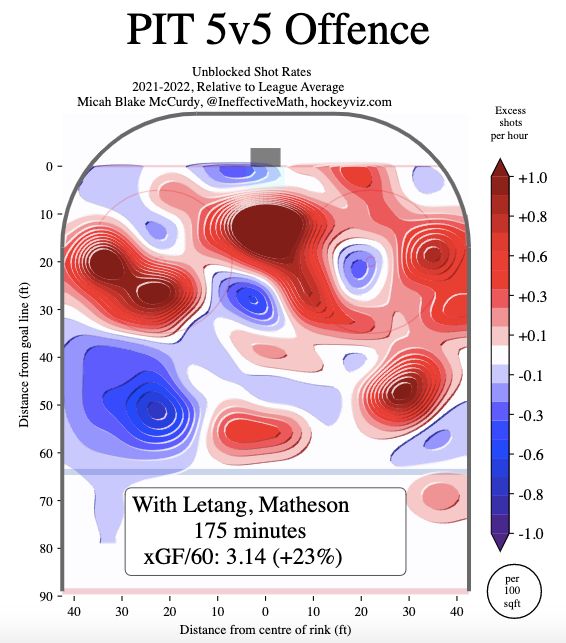
HockeyViz
Like I said, the Penguins won't continue to fill the net at such a gaudy rate with those two on the ice, but there's no reason to anticipate a steep drop-off due to the fact they are getting to the most dangerous area of the ice with regularity.
Letang remains one of the NHL's top offensive defensemen, even if he's not quite keeping up with the likes of the Avalanche's Cale Makar, and Matheson is having the best offensive season of his career, but part of what has made the duo so successful offensively is their ability to stymie the opposition at both blue lines and sustain pressure up ice:
Few NHL defensemen have been as efficient at denying opponents from gaining the offensive zone as Matheson this season. In certain situations, Matheson can translate that skill to prevent the opposition from exiting their own zone.
It all starts with his magnificent skating and edge work. Without it, he wouldn't be able to keep as tight of a gap on his assignments as they look to transition.
After Matheson broke up an outlet pass to Nino Niederreiter, the Penguins were able to regain possession and establish their presence in the offensive zone. They eventually worked the puck back up top to Matheson, who immediately recognized the Penguins' numbers advantage at the front of the net and got the puck to his hip-pocket. He sent the puck flying and Danton Heinen was able to deflect it to the back of the net.
When the Penguins have Matheson and Letang on the ice with Sidney Crosby's line, all five skaters are a legitimate threat to shoot or make a play. The same can't be said when Dumoulin is the one alongside Letang. That's not necessarily a knock on Dumoulin. Offense has never been his game. But the added threat of Matheson playing with the other big guns makes the Penguins' attack that much more dynamic.
Defensively, Matheson and Letang haven't been stalwarts, but they haven't been a mess either:
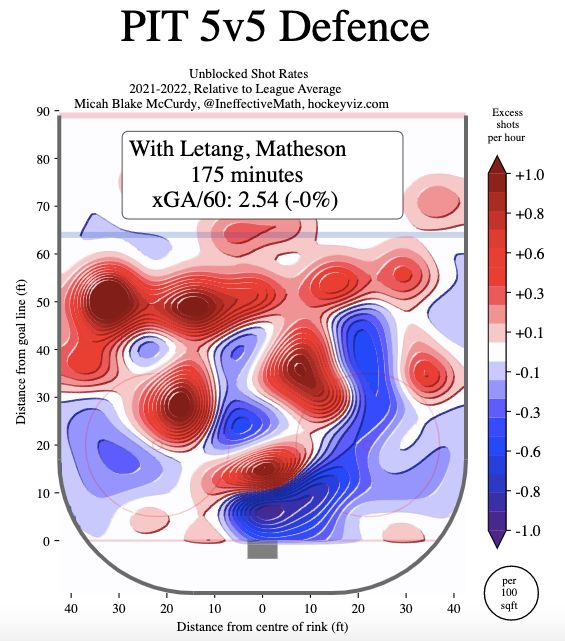
HockeyViz
For the most part, opponents are spamming shots from the point and tops of the circles, but have also had some success getting to the slot.
Because Matheson and Letang thrive with the puck on their sticks, there will be times where both players can be a little too eager to command the puck, creating confusion between the two while feeding the opposition's counter-attack in the process:
The reason for that goal against is obvious: Matheson and Letang had a miscommunication at the point and let the puck get past them. But how did they end up in such a compromised position?
After Matheson did a good job to get off the wall and toward the middle before firing a shot, both blue liners drifted away from the flow of the puck. Because both players are such gifted skaters, you'll notice that they will try to stay in motion and use their edges to quickly change direction if needed, but there's certain cases where the best route is to simply stay put.
The Penguins had all three of their forwards in or shaded toward the corner, and with the defensemen drifting backward, a whole lot of ice opened up in the middle. That's how you expose yourself to quick counter-attacks. If you look at the teams that give up the most odd-man rushes, you'll notice that the issue often stems from having too much separation between forwards and defensemen in the offensive zone. On a change of possession, the forwards might be too deep in the zone to apply pressure, and the defensemen are so high that they aren't able to maintain a tight gap.
This pair will have their fair share of mishaps along the way, but considering their offensive generation, it's well worth the occasional blunder.
DUMOULIN-MARINO
- 5v5 on-ice goals: 2-7
- 5v5 on-ice expected goals share: 41.3%
- 5v5 on-ice shot attempts share: 39.3%
- 5v5 ice-time together: 121 minutes
Dumoulin has had an up and down season. I like the idea of getting him away from Letang, but I have my doubts that a partnership with Marino is a recipe for success.
Despite the impression that Marino has the tools to be more effective offensively, the reality is that he is dragging down the Penguins' ability to generate quality offense to a degree that is on par with Dumoulin's offensive struggles.
With Dumoulin and Marino on the ice together at full-strength this season, the Penguins are scoring a lone goal per hour. That's atrocious. Sure, they have been a bit unlucky shooting-wise, but the volume and quality of attempts in that time are nowhere near acceptable levels:
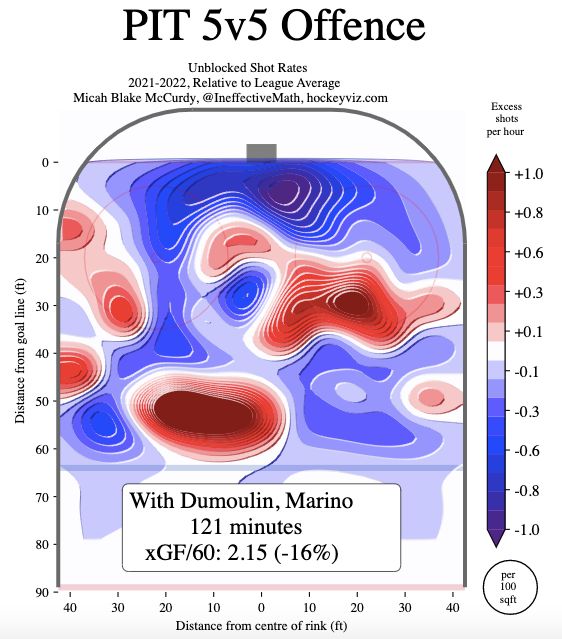
HockeyViz
This pair has started 15% of their shifts in the defensive zone (highest of the three pairs) compared to 9% in the offensive zone, but that simply doesn't account for the utter lack of an offensive pulse.
If the Penguins hope to get somewhat consistent secondary scoring, this pair has got to show more life on the attack.
It would be an easier pill to swallow if they were shutting the opposition down, but they are giving up more shots and chances than the top and bottom pair by a somewhat significant margin:
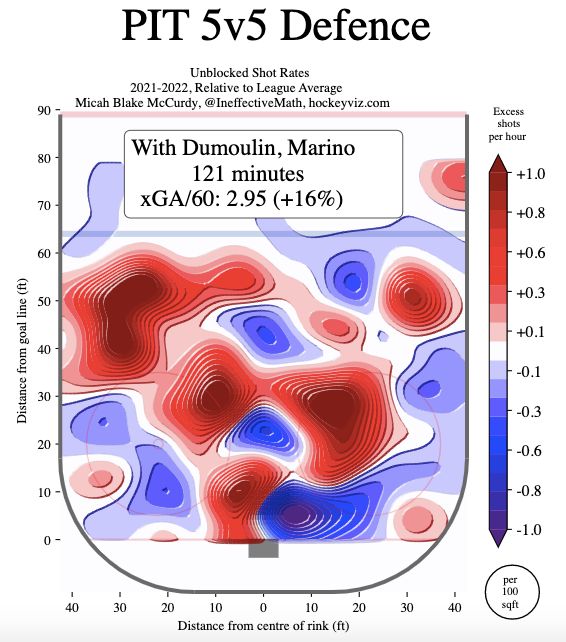
HockeyViz
Their issues at both ends of the rink stem from one glaring problem -- an inability to exit the zone cleanly on a regular basis:
I should note that the Penguins will sometimes have their weak-side winger sprint up ice directly after a defensive zone faceoff win while the defenseman attempts to hit them in-stride with the old school Larry Murphy dump, but in the clip above, Marino should have been aware that he had no sprinter.
He panicked under pressure and flubbed a puck right back to the Hurricanes. It might seem harmless, but Dumoulin and Marino throw far too many pucks away in the defensive zone by swatting their sticks at the puck or by lofting the puck into the neutral zone with no clear goal other than to get the puck off their sticks.
This is how you end up getting outshot by nearly 27 attempts per hour. Yes, it's that bad.
I'm not saying they need to hang on to every single puck or make a tape-to-tape pass every single time, but at some point they have to start making plays to exit the zone with possession or they will continue to spend the majority of their ice-time defending.
FRIEDMAN-RUHWEDEL
- 5v5 on-ice goals: 5-5
- 5v5 on-ice expected goals share: 64.7%
- 5v5 on-ice shot attempts share: 55.1%
- 5v5 ice-time together: 121 minutes
The Friedman-Ruhwedel pair is breaking even in terms of goals, but they have been phenomenal at controlling the overall quality of play at both ends of the ice.
Both defenders complement each other well. Friedman is extremely aggressive when it comes to joining the rush and activating in the offensive zone, while Ruhwedel serves as the smooth and reliable safe-guard.
Their offensive results are extremely impressive:
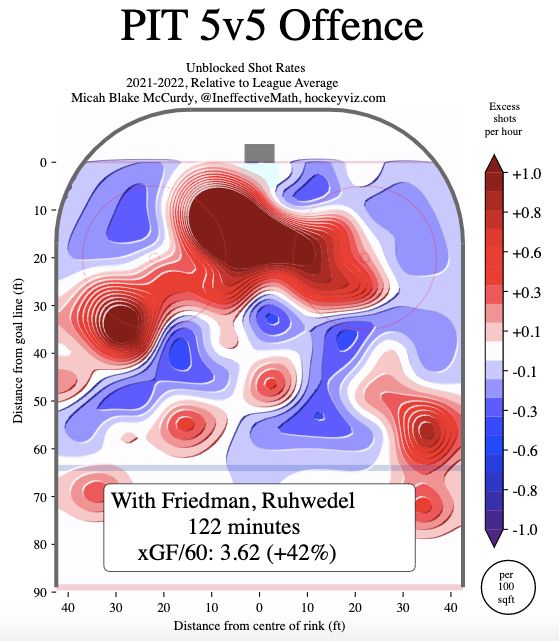
HockeyViz
Again, this is a two-hour sample, so don't expect their output to last forever, but it should remain very strong thanks to Friedman's willingness to get involved on the attack:
For a guy that has pretty average hands, Friedman certainly doesn't play like it.
Defensively, Friedman and Ruhwedel are very good at hunting down loose pucks and keeping pressure away from the front of the net:
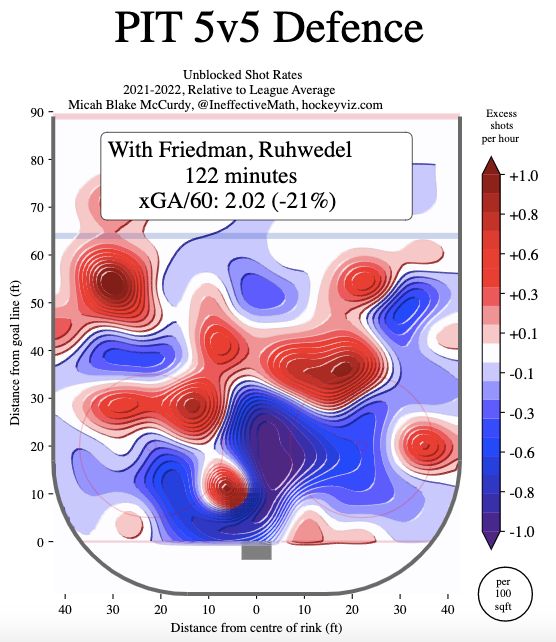
HockeyViz
Neither defender has a very large frame, but they make up for it with their quickness and anticipation.
You'll also come to notice that both players will defend rush attacks by skating forward rather than backward when the opportunity presents itself. This prevents the puck-carrier from being able to manipulate their feet to get around them:
This pair has started just 6% of their shifts in the defensive zone compared to 14% in the offensive zone, so they are definitely getting favorable deployment, but that doesn't change how dominant they've been to this point.
All things considered, the Penguins could be in much worse shape on the blue line. Their middle pair needs to be better if any of these duos are to stay together, but their top and bottom pairs are playing as well as you could ask.
At the very least, it's a good thing Sullivan is going through this experiment now when the stakes are still relatively low. That said, don't be surprised if the pairs revert back to what they've been most of the campaign by the time the postseason rolls around.

